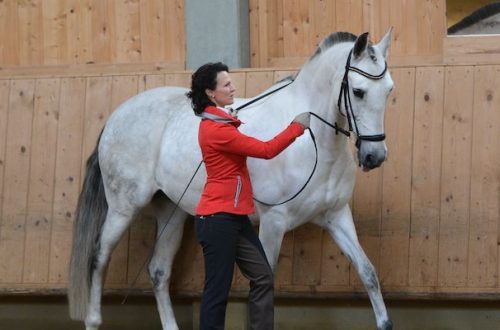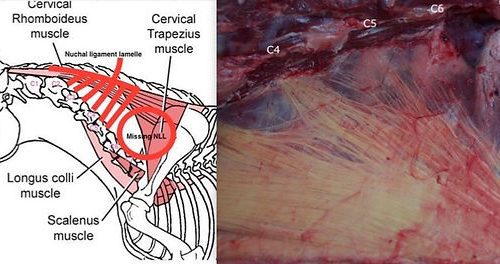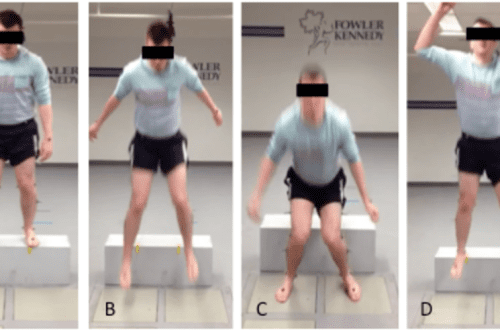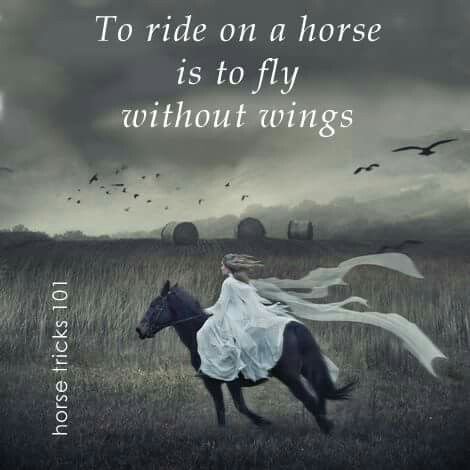
How to consider the horse’s status?
How to consider the horse’s status?
A horse’s conformation is directly related to its performance as a riding horse and, of course, its sporting prospects. That is why it is important for equestrians to know how conformation defects affect the quality of movement and performance of the horse.
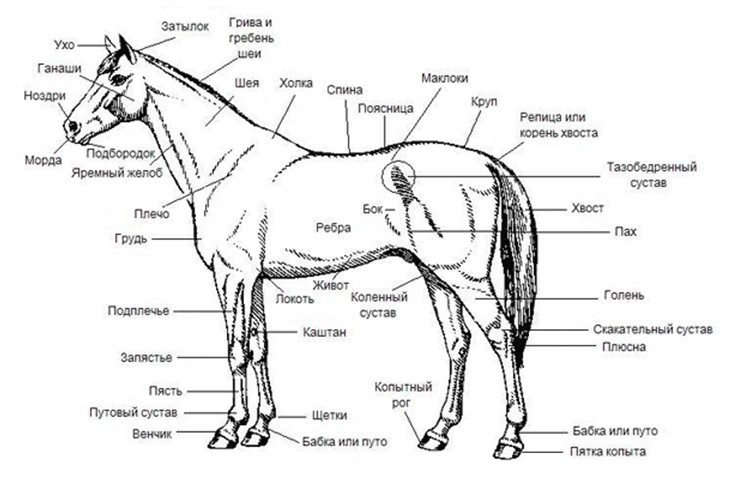
horse muscles
Signatures: Shoulder, Chest, Shoulder, Loin, Croup, Thigh, Calf.
Muscle is an important criterion in evaluating a horse’s constitution. They must be developed proportionately and evenly. Visually they are evaluated in the places indicated above. A horse that is in good athletic condition has clear, well-defined muscles.Heavy horses have more developed muscles in the shoulder, lower leg and hindquarters than lighter horses.
Horse balance
For the most part, horses are proportionately developed, but not necessarily balanced. Balance is the most important characteristic when choosing a horse, because it is the basis for the movement, stride length and, ultimately, the performance of the horse.
Balance is determined by the basic skeletal structure of the horse. It is important to develop the ability to visualize and evaluate the horse’s skeletal system under the muscles and other tissues.
The slope of the horse’s shoulder is critical to the horse’s balance. The slope of the shoulder changes dramatically as the angle of the shoulder increases and decreases. Not only does the ratio of the top of the neck to the bottom change, but the ratio of the length of the back to the length of the underline also changes. A long top line and a short bottom line are considered ideal.
Physiologically, the straighter the shoulder, the further forward the withers are placed, resulting in a longer back from the withers to the loin. The length of the line of the bottom from the elbow to the knee does not depend on the change in the slope of the shoulder. Therefore, a horse with a straight shoulder will have a tube-shaped body.
Since horses are proportionate, a horse with a straight shoulder will have a long back, a short neck, a short and steep croup, and a steep knee and pastern. Such a structure will greatly affect its course.
Front legs of a horse (front view)
The forelimbs of a horse account for 65% of its body weight. Therefore, it is extremely important for a horse to have straight, structurally correct forelegs. Defects in the structure of the legs can lead to an increased risk of injury and the occurrence of chronic diseases.
Ideally, when examining the forelimbs, a straight line from the point of the shoulder should bisect the entire column of bone down to the hoof, with an equal amount of bone on either side of the line.
The hoof and carpal joint should point straight ahead, although this is rare. The width of the hoof at the base should be the same as the width of the leg at the exit of the chest. The pastern should be centered at the carpal and fetlock joints.
When viewed from the front, we can see several possible deviations from the ideal structure. They can affect the movement and performance of the horse.
In horses with clubfoot hooves turned inward markup – outside. In both cases, horses are more likely to stumble, get caught.
Another deviation in the structure of the front legs is called narrow set. With this set, the horse’s hooves are shifted to the center (the hooves are located closer to each other than the legs at the outlet of the chest). This position is typical for heavy horses. Horses put their hooves close to each other, the hoof stands on the outer wall. Due to the extra weight on the outer wall, the horse can develop diseases such as toad, ossification of the coffin cartilage, etc. Horses with this structural feature may also have a size or clubfoot.
The horse with wide lineup the distance between the hooves on the ground is wider than the distance between the legs at the exit of the chest. This structure is often seen in narrow-chested horses and is often accompanied by size. Because of this, more weight is placed on the inner wall of the hoof, which causes frogs and ossification of the coffin cartilages. Horses with a wide stance have their legs wide apart when they walk.
Wide and narrow set.
Turned out postav – when viewed from the front, the carpal joint seems to be twisted outward. This structure causes increased stress on the outer part of the leg due to the fact that when the hoof hits the ground, the impact on the leg spreads unevenly.
RџSЂRё cow’s back the carpal joint is not in a straight line from the exit of the leg from the chest to the hoof, but is displaced inward. This defect is usually accompanied by a clubfoot and a slightly turned outward metacarpus. When a horse moves and its hooves hit the ground, there is an unequal distribution of the impact on the bones of the leg, which can cause limb diseases.
Displaced metacarpus – the metacarpus comes out of the carpal joint not in the center, but closer to the outer edge. Such a flaw can cause splits.
Turned out postav. Cow posture. Displaced metacarpus.
Influence becomes a movement.
Front legs (side view)
Perfect set of front legs.
Seen from the side, the forelimb should have an appropriate slope and angle of the shoulder and pastern. Also, a straight line should run from the center of the shoulder blade and bisect the foot, touching the heel of the hoof at the back, as shown above.
Extended forelimbs is a fault in which the forelimbs are brought too far back under the body of the horse. This posture prevents the horse from having a long, smooth stride and predisposes to limb disease. It also causes increased pressure on ligaments and tendons.
Retracted forelimbs – this is a flaw in which the forelimbs of the horse are laid forward from the body. It causes the carpals, fetlocks and hooves to be subjected to undue stress. Horses with this posture often develop navicular syndrome and laminitis.
Kozinets – This is the most common defect associated with the structure of the carpal joint. The carpal joint is pushed forward in relation to the line of the leg. Note, however, that many horses with Kozins successfully compete in tournaments.
Kozinets.
sunken wrist – a flaw opposite to the kozin. This is a very serious defect, as it leads to significant disturbances in the functioning of the limb. The horse’s wrist is drawn away from the line dividing the bones of the forelimb in half when viewed from the side, back. A sunken wrist bends backward and can cause injury.
Sunken wrist.
Ideal Headstock Tilt: 45 degrees for the front and 50 degrees for the back.
Short, cool money cannot provide the forelimb with normal depreciation. Steep grandmothers give the horse’s step slovenliness, lack of grace. Also, a steep pastern predisposes to the development of lameness, since the horse’s limb is subjected to unnecessary stress when moving.
Short, steep pasterns.
Long weak pastern also cause injuries to tendons and ligaments.
Horse’s head
The structure of the head may vary among horses of some breeds, but in most cases the attractiveness and structural correctness of the head have approximately the same characteristics.
These characteristics include:
- · short, well set ears;
- Large, clear eyes
- small distance from snoring to eyes;
- large nostrils;
- exquisite muzzle with a small mouth;
- sexual characteristics (stallion, mare);
- pedigree features.
A beautiful head does not give the horse any physiological benefit to the horse. Rough-headed horses can perform just as well in sports as neat and beautiful-headed horses.
The ears should be in proportion to the horse’s head, but their position on the head may vary. The ears should sit straight, point forward and have an attractive appearance. Some horses have their ears turned inward, some outward, and may be set slightly wide and down.
The eyes should be positioned at the corners of the head to provide a 300 degree view. Large eyes with a soft expression usually indicate a calm, obedient nature of the horse. Small “pig” eyes testify to some sullenness of their owners. It is sometimes said that such horses are difficult to train. Horses with highly visible sclera are usually nervous and shy. A good eye should be bright, calm and have a soft, kind expression.
Horses with open, bright eyes set wide apart in combination with a slightly concave profile have increased depth perception and better peripheral vision. They are easier to train because they are less afraid of what is happening around them.
Horses with small, closely spaced eyes and a convex profile have limited vision. They tend to be more shy.
The horse must have a well defined jaw. Stallions have a larger, deeper, more pronounced jaw than mares – this is a secondary sexual characteristic.
It is very important to examine the horse’s mouth – it should not be undershot or undershot. The depth and shape of the mouth affects the “ease in the bit”. As a rule, the deeper the mouth, the softer and more responsive the horse.
“Parrot’s Beak” (snack) and “bulldog jaw” (overshot).
horse neck
The length and shape of the neck is important because the horse uses it as a balancer.
Particular attention is paid to ganaches – the area between the head and neck from ear to ear from below.
If the ganaches are narrow or meaty, it will be difficult for such a horse to give in at the back of the head – he will have difficulty breathing, and blood flow will also be disturbed. Ganache of sufficient width, thin throat will allow the horse to collect and maintain proper respiratory function.
The ratio of the top line and the bottom line of an ideal neck will be approximately equal to two to one. The top line of the neck is the distance from the back of the head to the withers, and the bottom line is the distance from the ganache to the junction of the neck and shoulder.
The neck is usually in proportion to the overall length and height of the horse. Of course, shorter and smaller horses will always have shorter necks than tall ones.
The ratio of the top line of the neck to the bottom line is determined by the slope of the horse’s shoulder. When the shoulder is more sloping, the upper line is even longer in relation to the lower one. Therefore, if the shoulder is straighter, the ratio of topline to underline decreases. When the ratio approaches 1/1, the horse’s neck looks square. The withers of a horse with a straight shoulder are moved forward, so the top line of the neck is shortened. A straight shoulder has little effect on the length of the lower line of the neck.
The connection of the upper and lower lines of the neck and the slope of the shoulder.
Hind legs of a horse (side view)
The correctness of the hindquarters is determined by a line that runs from the point of the buttocks, through the point of the hock joint, runs parallel to the metatarsus and ends slightly to the side behind the heel of the hoof.
The horse with saber the hocks are bent at a very large angle. The leg below the hock stands under the thigh and forms a sickle shape. This posture predisposes the horse to the development of the curb. Many horses with this stance perform well in the sport, but their success is short-lived until limb injuries begin to show.
Retracted hind limbs located behind the buttock point behind an imaginary line. This defect prevents the horse from bringing his hindquarters down, preventing collection. Horses with this set-up tend to “drive” their feet into the ground during the movement and cannot push backwards well.
In horses with straight hindquarters insufficient hock angle. The hind legs are almost straight. Such horses are uncomfortable under the saddle, they “drive” their legs into the ground and cannot bring their hindquarters, which makes collection impossible.
Hind legs of a horse (back view)
Ideally, when we consider the structural correctness of the hind limbs from behind, a line drawn from the point of the buttock through the lower leg, hock and hoof should divide the leg into equal parts.
Such a straight leg will allow for an even distribution of weight and impact on the ground when moving on bones, tendons and ligaments. In most cases, if we are looking at a horse from behind, its metatarsus will be parallel and its hooves will be turned slightly outward.
This is quite acceptable because it allows the hip to move freely along the chest during the lengthening of the stride, a freer movement.
Hind limbs of a horse, rear view.
The horse with cow’s postav the hocks are close together, and the metatarsus is not parallel to each other. The hocks look at each other, and the hooves look to the sides. These horses have trouble with basic movements that require hind limbs, such as stopping, turning, and gliding.
Cow posture
RџSЂRё vyvoročennom poste hocks point outward and hooves inward. The hocks are too far apart. These horses usually have a wide stance. This condition increases stress on the bones, ligaments, and joints and interferes with movement. It is not advisable to use such horses in sports.
Turned out position.
Horse topline
The horse’s topline includes the withers, back, loin and croup. Seen from the side, a properly balanced horse should be higher at the withers than at the croup. When the withers are higher than the croup, the hindquarters are correctly positioned and the horse can move in a balanced manner, which increases its sporting value. The strength of the topline and loin muscles affects the horse’s ability to stay in good physical condition for a long time and its athletic ability.
The ideal withers should be clear and well defined. A well-defined withers helps keep the saddle in place without over tightening the front of the chest. A rounded or flat withers can cause the saddle to slip and you will have to tighten the girth more, which means less comfort for the horse.
Horses should have a short, strong back in relation to a longer underline. The length of the back plays an important role in the balance, length and stride characteristics. The length of the back is directly related to the length and slope of the shoulder and the ratio of the top and bottom lines of the neck. Horses with excessively long backs are less balanced, with long backs weaker than short backs.
The loin is located between the last rib and the croup. She should be muscular and strong. A bad loin is long, weak and poorly muscled. Short, muscular loins are needed to transfer power from the hindquarters forward.
The croup should be long and flat. Such a croup adds stride to the horse, it also affects the development and muscularity of the hindquarters. The ideal croup for horses of different breeds may vary
The ratio of the bottom line and the top.
Ashley Griffin; translation by Valeria Smirnova based on materials from the site http://articles.extension.org/.



